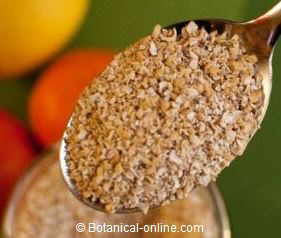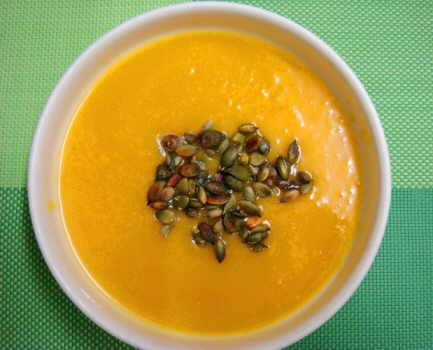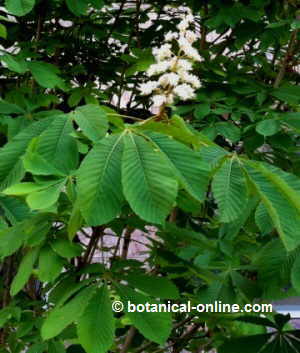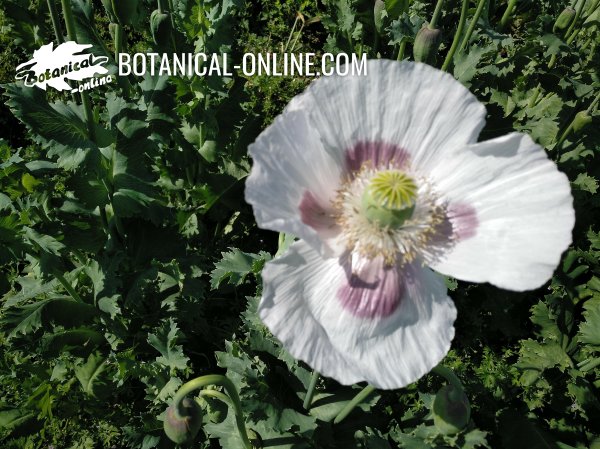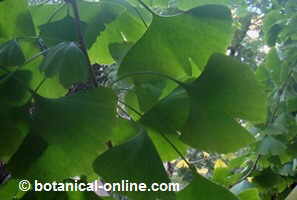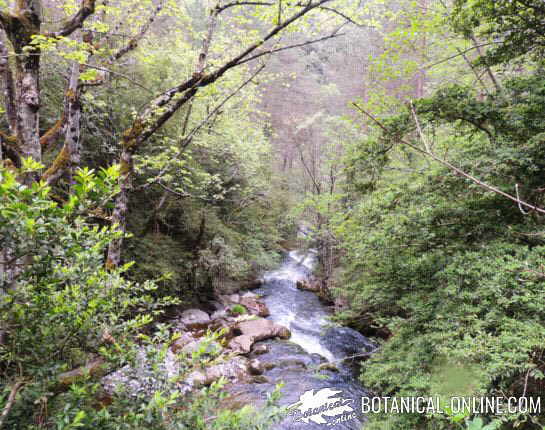Main varieties of European beech:
The main varieties of European beech are the following:
- Fagus sylvatica F. purpurea: rounded and with purple-green leaves that turn copper in autumn. Species that prefers sunny places. It is planted in large parks or as a hedge.
- Fagus sylvatica «Tricolor»: smaller in size than the previous one, it has bruised leaves with striped edges of cream and pink tones.
- Fagus sylvatica «Dawyck»: Another species that has darker purple leaves. The crown has a more stylized look.
- Fagus sylvatica «Riversii»: It is the one with darker purple leaves.
- Fagus sylvatica “Pendula”: Presents an umbrella-shaped crown from which hang the branches that cover the trunk and reach the ground. It is known as weeping beech.
- Fagus sylvatica «Aspleniifolia»: Its bright green leaves resemble those of ferns.
- Fagus sylvatica «Rotundifolia»: With small and rounded bright green leaves.
- Fagus sylvatica «Tricolor»: Purple-pinkish leaves with white-pinkish margins.
- Fagus sylvatica «Pyramidalis»: With a pyramid shaped crown.
- Fagus sylvatica «Tortuosa»: Variety that has very few specimens. There are only about 1500 in France, Germany and Denmark. They are mutant trees with tortuous and hanging branches that give it a mysterious appearance, especially when leaves fall. Well-known are the “Faux de Verzy” specimens in Reims.
How to grow beeches
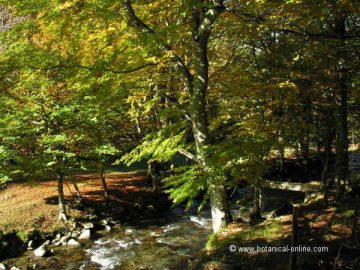
Beech irrigation and humidity
A beech is the tree typical of the flat-leaf deciduous forests of temperate climate. Within this type of forest we find trees as characteristic as beech trees (Fagus), oaks (Quercus), birches (Betula) maples (Acer) etc.
It grows in wetlands, with average annual rainfall around 1000 to 1200 liters. It needs at least about 900 liters of annual rainfall to be able to develop, except in the Nordic countries where temperatures are less elevated and can do so with about 500 liters. In other places located further south, with particular humidity and rain characteristics, it can live with rainfall between 550 and 600 liters per year.
Although it is a tree that needs a lot of moisture to develop, it can withstand dry periods when it is well rooted, since its roots can look for retained moisture in the deeper layers of the soil. In areas where rainfall is lower, it usually develops surface roots, very prominent especially in older specimens, to capture the environmental humidity that is deposited on the ground.
The soil where the beech trees are planted must maintain a certain humidity, although those soils that are flooded are not adequate, which leads to root rot and fungal diseases.
Planted in the garden, it will need to be watered abundantly during the growing seasons when it is young, especially during the summer. As it grows , watering will decrease. Adult specimens do not need to be watered when the rainfall regime is adequate.
Beech environment and location

Beech trees grow in full sun or semi-shade, being able to adapt in more shady places when they are young. Green leaf varieties prefer more shaded places, while red leaf varieties prefer sunny ones.
As a temperate tree, it grows in those places where summers are not very hot and winters are very cold. It cannot be planted in areas with hot climates or in regions with very cold summers.
Beech forests grow in a natural state in areas of influence of the Atlantic winds that provide abundant rains well distributed throughout the year. It can grow in high places of Mediterranean climate between 450 and 1800 meters of altitude. To do this, it looks for the slopes of the mountains facing north, where the heat is lower and the humidity is maintained for a longer time.
They cannot live with the lack of rain and the excessive heat that characterizes the summer periods of the Mediterranean climate or the lack of seasonality of hotter climates. Nor does it adapt to the cold summers of northern latitudes. They are tolerant to winds, although, because they have superficial roots, they can easily uproot them if they are not well established, so it is convenient to plant them under a tree that protects them when they are young.
The beech trees do not support the salinity of the soil or the environmental salinity, so it is difficult to find them next to the coastal zone.
Geographically, they are usually between 40º and 55º north latitude. The drawing in the right column shows the distribution area of this tree in green.
Beech Applications
It can be used as a shade tree in large parks or gardens.
Beech forests are mainly exploited for their wood (See more information on beech wood)
As a medicinal and food plant, it was widely used in the past.
Growing potted beech: Beech can be grown in a pot with the bonsai technique.
Beech Reproduction and care
Reproduction can be carried out by seeds and grafts.
Seed reproduction of beech
Before sowing, seeds should be prepared well. The seeds are collected when they are very ripe and the fruits have been opened. They are stored in a cool and dry place once the bark is removed.
Before sowing them it is advisable to stratify them about three months in cold and then stratify them a few days with heat. To do this, they can be stored in the fridge wrapped in a mixture of peat and pearlite in a very wet plastic bag. It is advisable to keep the humidity constant so it should be checked from time to time to verify that there is no lack of water. After this time, a couple of weeks will be placed in a warm place to start activating germination.
Although they can be planted in a seedbed, and subsequently transplanted, it is convenient to sow stratified seeds in their final location, once the soil has been properly prepared.
Seeds can also be planted without stratifying in seedlings or at their final location, although the chances of germination are lower.
Where and how to place the seeds
In case of intensive plantations, an approximate distance of about 15 meters from each other should be maintained. Germination will occur in spring.
To prevent direct sunlight from spoiling the seedlings, they can be planted under other trees. When they grow they will eliminate them by stealing the light and attacking them with toxic components.
As the seedling grows, it should be watered regularly until it is well established.
Mulching the soil will allow to maintain the humidity with greater regularity at the same time that will avoid the appearance of weeds, will keep the heat and will facilitate a better absorption of the nutrients. Any type of decomposed organic matter or even the leaves of other beech trees can serve this purpose.
Beech grafts
Beech grafts, in the form of a cleft or veneer grafting, made on beech feet previously reproduced with seeds, can be purchased from specialized nurseries. This type of reproduction achieves specimens that grow faster while ensuring greater genetic quality.
Beech maintenance tasks
Beech trees do not tolerate transplantation well, so it is better to reproduce them with the previous methods. Reproduced in one way or another, the beech trees require little maintenance:
- During the first years, the herbs that grow around them must be removed manually and an adequate irrigation should be maintained.
- Because this tree develops many superficial roots, with machines should be avoided.
- Beech trees, unlike other leafy ones, such as oaks, willows, ash or chestnut trees, do not regrow very well once the main trunks are cut at ground level or near it so that new stems regrow and produce many thin trunks and together from a main trunk. This is the reason why the stem production technique has not been applied in beech forests, so common in the other trees mentioned. Therefore, most beech trees in the current forests are adult specimens with a well-defined main trunk and quite separate from each other.
- Beech trees can be pruned if vertical growth is desired. For this, lateral and inferior branches will be removed and the main stem will be left. Since they admit to be pruned, they are often used in some countries in the construction of hedges, especially purple varieties.
Beech soil and fertilizer
Beeches prefer soils with a slight acidity although they support alkaline soils. They need rich, deep, well disaggregated and fresh soils such as sandy and loamy soils. They do not adapt on very compact terrain, whether clayey or silty.
These trees have a great capacity to extract nutrients from the soil and the environment, so that adult specimens will practically not need to be fertilized. Younger specimens are favored with the addition of nitrogen fertilizers such as well-made manure.
Beech plagues and diseases
Aphids, beetles and powdery mildew
European beech trees are very resistant trees that do not present many problems with respect to pests and diseases. They can be attacked by aphids that suck their sap by piercing their leaves or by beetles that eat their leaves. Among the main diseases that affect it is the powdery mildew.
American beech trees are more prone to suffer plagues and diseases. This is the reason why this tree is being replaced by the European one as an ornamental tree in parks or gardens.
Beech bark disease
Beech bark disease is a fungal disease that causes the Cryptococcus fagisuga insect. The wounds produced by this insect cause the development of the fungi Neonectria faginata and Neonectria ditissima. The fungi, in turn cause the appearance of chancres in the branches of the trees that will end as dead bark circles around the entire branch, which causes the death of the part of the branch located above the circle.
This disease affects both American and European beech, although the latter is more resistant than the first.
It is advised as a treatment to avoid the contact of infected material with healthy trees, eliminate all the infected material and select those specimens most resistant to it.
Beech leaf disease
A new disease, known as Beech leaf disease, has recently appeared in American beech forests.
This disease, which has no cure, manages to prevent the birth of the leaves in the beech trees, which causes the death of the affected tree. It is a pest that affects both the American species and the European one.
At the moment it has been extended mainly by some states of the United States and Canada, but, if not finding a solution, could endanger both species.
![]() More information on beech
More information on beech


